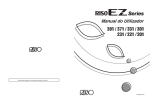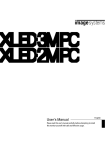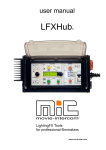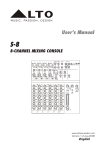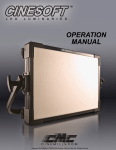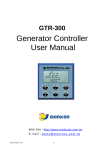Download Operation Manual Image 85/45 DMX
Transcript
Operation Manual Image 85/45 DMX Image 85 Yoke Mount Image 85 Pole-Op Part No. 3100035 Rev C 01-04-2010 Image Fixture Styles and Features Image Yoke Mount IMG-85X-120 Image 85 DMX Yoke Mount, 120VAC IMG-85X-230 Image 85 DMX Yoke Mount, 230VAC IMG-45X-120 Image 45 DMX Yoke Mount, 120VAC IMG-45X-230 Image 45 DMX Yoke Mount, 230VAC Image Pole-Op Mount IMG-85P-120 Image 85 DMX Pole-Op Mount, 120VAC IMG-85P-230 Image 85 DMX Pole-Op Mount, 230VAC IMG-45P-120 Image 45 DMX Pole-Op Mount, 120VAC IMG-45P-230 Image 45 DMX Pole-Op Mount, 230VAC 2 Included w/ all Image Models GFR-I80 Image 85 Gel Frame (Included) GFR-I40 Image 45 Gel Frame (Included) LVR-I80-S Image 85 Silver Louver (Included) LVR-I40-S Image 45 Silver Louver (Included) True Match® Lamps 488-K29-S 488-K32-S 488-K55-S 488-K10-S 488-K5-S 4ft Kino 800ma KF29 4ft Kino 800ma KF32 4ft Kino 800ma KF55 4ft Kino 800ma 420 Blue 4ft Kino 800ma 525 Green Note: Kino Flo recommends Safety-Coated 420nm Blue for Bluescreen and 525nm Green for Greenscreen. 3 Image 85 Yoke Mount Kits KIT-I85-X1/120 Image 85 DMX, Kit, 120VAC KIT-I85-X1/230 Image 85 DMX Kit, 230VAC Image 85 Yoke Kit Kit Contents: 1 Image 85 DMX Yoke Mount 1 MTP-I80 Mount 1 Ship Case Dimensions 56.5 x 8 x 35” (143.5 x 20.5 x 89cm) Weight 65 lb (29.3kg) KIT-I85-X2/120 Image 85 DMX, Kit, 120VAC (2-Unit) KIT-I85-X2/230 Image 85 DMX Kit, 230VAC (2-Unit) Image 85 Yoke Kit (2) Kit Contents: 2 Image 85 DMX Yoke Mount 2 MTP-I80 Mount 1 Ship Case Dimensions 56.5 x 16 x 35” (143.5 x 40.5 x 89cm) Weight 167 lb (75.2kg) 4 KIT-I85-X4/120 Image 85 DMX, Kit, 120VAC (4-Unit) KIT-I85-X4/230 Image 85 DMX Kit, 230VAC (4-Unit) Image 85 Yoke Kit (4) Kit Contents: 4 Image 85 DMX Yoke Mount 4 MTP-I80 Mount 1 Ship Case Dimensions 35 x 33 x 64” (89 x 84 x 162.5cm) Weight 353 lb (160kg) Image 45 Yoke Mount Kits KIT-I45-X1/120 Image 45 DMX, Kit, 120VAC KIT-I45-X1/230 Image 45 DMX Kit, 230VAC Image 45 Yoke Kit Kit Contents: 1 Image 45 DMX Yoke Mount 1 MTP-I80 Mount 1 Ship Case Dimensions 56.5 x 9 x 23.5” (143.5 x 23x 59.5cm) Weight 48 lb (21.6kg) 5 Inserting Lamps Insert lamps into both lamp holders. Twist ¼ turn to make electrical contact. Inserting Gel Frame The gel frame is secured to the fixture by 4 spring-loaded pins. Align the pins of the gel frame with the oval receptacle holes on the edge of the fixture. Pull back the pins and release into the receptacles to properly secure the gel frame. Applying Gel to Frame A) The Gel Frame comes with Gel Clips. Cut the gel to size and use the Clips to fasten the gel to the Frame. (A) (B) B) Another method is to apply transfer tape directly to the gel frame. The clips are not necessary when taping the gel. 6 Inserting Louver Place the long edge of the Louver into the lower channel containing a set of leaf springs. Press down on the Louver and slip the upper edge of the louver into the upper channel of the fixture. To remove reverse the procedure. Mounting Barndoors Side Door (x2) Top and Bottom Door 1. For the Side Doors, align the hinge bracket tabs with the two square receptacles on the side of the fixture. 2. Press the tabs of both brackets into the square receptacles. 3. Slide the two brackets up until the silver lock pin snaps into place. 4. To release the Barndoor, press the lock pin down and slide the bracket in reverse. 7 1. For the Top and Bottom Doors, align the two hinge bracket tabs with the two square vents closest to the silver lock pins. 2. Press the brackets down into the vent and slide them over to engage the lock pins with the hole in the bracket. 3. To remove the Barndoor, press down on the two lock pins and slide the brackets back. Adjust the hinge tension with a Phillips head screwdriver. 8 Image Yoke Mount The Yoke has a ½” hole to accept industry standard mounting hardware. The Image 85 Yoke Mount can hang from a grid by a junior pipe hanger using a Yoke Junior Pin (MTP-I80), sold separately. The Image 45 Yoke Mount can also hang from a grid by a junior pipe hanger using a Yoke Junior Pin (MTP-I80) or hang from a baby pipe hanger using a Yoke Baby Receiver (MTP-I40) also sold separately. The MTP-I80 includes a long bolt for the Image 85 Yoke Fixture and a short bolt for the Image 45 Yoke Fixture. Note: Because of weight capacity, the MTP-I40 can only be used on the Image 45 Yoke Fixture. Image Pole-Op Mount The Image 85 and 45 Pole-Op Mount fixtures include a yoke with an attached junior pin. They can be hung from a grid with a junior pipe hanger. Junior pin attached to Pole-Op Yoke 9 Pole Operation The Blue cup alters the Pan (left or right). The White cup alters the Tilt (up or down). Image Fixture DMX Control Panel The Image 85 Fixture is used for example purposes throughout these instructions. A B C D E F G H I J A) Remote Jack: Input for remote hand-held lamp control. Turns lamps on and off manually without connecting to DMX. B) Manual Selector Dial: Turns lamps on and off manually without connecting DMX Cable to Fixture. C) HO/STD Selector Switch: HO setting operates all lamps in fixture at High Output. STD setting operates all lamps in fixture at Standard light output. (STD is ½ f-stop lower than HO.) D) Power Switch: Has a built-in indicator light, which can detect if AC power is present in power cord. "O" = OFF position. E) Fuse: Provides circuit protection. Note: If Fuse is "blown" or "open" replace with same type of fuse rating as marked. F) DMX Address: Sets DMX Address of Fixture. G) DMX Indicator Lamp: Lights if DMX is present and conforms to DMX512, 1990 H) Individual Lamp / Fixture Switch: Converts between INDIVIDUAL LAMP and FIXTURE methods of DMX control. 10 I) DMX-In & DMX-Out: DMX-IN receives DMX signals from Dimmer Board. DMX-OUT relays DMX signal through to other Fixtures or Instruments. J) DMX TERMINATE Switch: Terminates DMX signal at the end of Fixture series. IMPORTANT! The dimmer board/light console should have its channel set to LINEAR light output response. (LINEAR response is the default setting on most dimmer boards.) Power Requirements Provide 120 Volt AC primary power. Do not dim the fixture through a dimming circuit. If powering the fixtures through a dimmer board, set the dimmer profile to non-dim. Load Considerations: Kino Flo ballasts are not power factor corrected. They will draw double the current on the neutral from what is being drawn on the two hot legs. On large installations it may be necessary to double your neutral run so as not to exceed your cable capacity. Manual Operation The REMOTE jack enables the use of a handheld remote controller (Accessory Part # DIM-5, see page 17) to turn on lamps. IMAGE 85 and 45 DMX Fixtures may be operated manually with the Manual Lamp Selector Dial. The Dial enables you to turn lamps on and off with an “inside-out” pattern (i.e., if all lamps are on, the outside tubes will turn off first). The HO/STD switch sets the output level of all the lamps in the fixture. In HO mode all lamps operate at a High Output level. In STD mode all lamps operate in Standard light output. There is about a ½ f-stop drop in light in the STD mode. 11 DMX Image 85 Switching DMX Image 45 Switching Note: Manual lamp switching, HO/STD as well as remote hand-held control (DIM-5) is disabled as soon as DMX cables are applied. For Manual control with DMX cables plugged in, set address to “000”. There is a 5 second delay when switching between DMX and Manual control. DMX Operation DMX Addressing Prior to hanging any instruments set the DMX address of each Fixture. Push the tabs above or below the number window to set the address. (Valid addresses range from 001 to 512.) The yellow light above the address block will illuminate if a DMX signal is present. 12 Image 85 - Each Image 85 fixture operates on 9 addresses. After the first DMX address is entered, the Image 85 Fixture automatically captures 9 addresses to lamps 1 – 8 and the 9th address to control the HO/STD Select feature. For the sake of simplification, it is advisable to select address sequences such as 10, 20, 30, 40 and so on. th The 9 address controls the HO/STD setting of all the lamps in the fixture. A dimmer level of 0%~50% sets the lamps in the HO mode. Dimmer settings from 50%~100% sets the lamps into the STD mode. Image 45 - Each Image 45 fixture operates on 5 addresses. After the first DMX address is entered, the Image 45 Fixture automatically captures 5 addresses to lamps 1 – 4 and the 5th address to control the HO/STD Select feature. For the sake of simplification, it is advisable to select address sequences such as 10, 15, 20, 25 and so on. th The 5 address controls the HO/STD setting of all the lamps in the fixture. A dimmer level of 0%~50% sets the lamps in the HO mode. Dimmer settings from 50%~100% sets the lamps into the STD mode. Note: Manual lamp switching, remote hand control as well as HO/STD switching are disabled as soon as the DMX cables are applied. For Manual control with DMX cables plugged in, set address to “000”. There is a 5 second delay when switching between DMX and Manual control. IMPORTANT! The dimmer board/light console should have its channel set to LINEAR light output response. (LINEAR response is the default setting on most dimmer boards.) The DMX Terminate Switch must be set to open ( O ) on Fixtures within the DMX chain. Set to closed ( I ) when the Fixture is the last DMX control device in the chain. Note: When the last Fixture's DMX Term is set to “I”, it will absorb all energy in the DMX line, ensuring DMX signals are transmitted correctly. If a signal is not terminated, it is called a “Reflected Wave”, and may create transmission errors by causing valid DMX signals to be canceled. Any theatrical lighting board with DMX512 protocol can be used to individually turn on/off lamps in a Fixture. Image Fixtures can be jumpered using the IN and OUT ports. As many as 100 Fixtures can be jumpered on one chain as long as the DMX cable run remains under 1000 feet or 40 x 25ft DMX cables. Note: When operating Fixtures at great distances from the dimmer board, it is recommended to use Opto-Isolators to provide DMX signal amplification. 13 DMX Cables The Fixture uses five-pin XLR male and female connectors to receive DMX signals from the Dimmer Board and jumper the Fixtures in a series. DMX pin-out wiring follows the USITT DMX512 standard: Do Not use Microphone Cables and other general purpose, two-core Cables designed for audio or signaling use. They are not suitable for DMX512. Problems due to incorrect cabling may not be immediately apparent. Microphone Cables may appear to work fine, but systems built with such Cables may fail or be prone to random errors. Cable must comply with EIA-485 (RS485). Pin 1: Shield Pin 2: Data Pin 3: Data + Pin 4: Spare Pin 5: Spare + Note: Pin four and five in the Fixture are connected internally as Pin four to four and Pin five to five. Connecting Pin four and five as the pass-thru allows secondary data to be passed through for other equipment. NOTE: If a fixture or Ballast loses its DMX signal it will hold its last DMX command. For this reason it is important to turn a Fixture or Ballast off using the DMX commands. For example, if you try to turn off the lights by turning off the dimmer board, the lights will remember their last DMX command and stay on. The Fixture or Ballasts require a DMX “Off” or “Black-Out” command in order to turn off. Fixture Lamp Mode Setting the unit to Fixture mode allows the user to re-create the “Inside-Out" pattern of the manual switch. One dimmer channel controls the lamps, a second channel the HO/STD setting. Assign the first address to a dimmer channel. Adjusting the slider up or down sets the number of lamps to be turned on. For HO/STD control on Image 85, assign the 9th address to the second dimmer slider. For Image 45, assign the 5th address to the second dimmer. From 0%~50% operates all the lamps in the fixture at HO mode, from 50%~100% in the STD mode. 14 One of the best applications for the Fixture mode is when lighting Blue and Green Screens or large Cycloramas. For example: One row of Image 85 fixtures can be set to Fixture mode on a common address. When the fader on the dimmer board is brought up or down, all the Fixtures on that address will have the same lamps turned on. Assigning the 9th address on all the fixtures renders control over the HO/STD settings. Dimmer level - Lamp response Sliding the fader on the dimmer board from 0% ~ 100% controls the number of lamps that are on within a fixture. Note: the lamps may respond ± 4 channel levels, depending on the dimmer board. IMPORTANT! The dimmer board/light console should have its channel set to LINEAR light output response. (LINEAR response is the default setting on most dimmer boards.) Image 85 Lamp Sequence DMX Lamp Sequence Lamp # Dimmer Level Lamp 1 6 Lamp 1~2 19 Lamp 1~3 32 Lamp 1~4 45 Lamp 1~5 57 Lamp 1~6 69 Lamp 1~7 82 Lamp 1~8 95 Image 45 Lamp Sequence DMX Lamp Sequence Lamp # Dimmer Level Lamp 1 12 Lamp 1~2 37 Lamp 1~3 64 Lamp 1~4 83 HO/STD Control: Image 85, assign a second dimmer channel to the 9th address to control the HO/STD mode. Image 45, assign the 5th address. Dimmer level 0%~50% operates all the lamps in the fixture at HO mode, from 50%~100% in the STD mode. 15 Individual Lamp Mode Setting the unit to Individual Lamp mode allows each lamp within the fixture to have its own address. Although this option will use up a lot of addresses, it may be preferable for certain situations. The Individual Lamp mode is useful in achieving light effects like flickering, chasing or creating light patterns. After the first DMX address is entered, the DMX Image 85 automatically captures th 9 addresses. Lamps are on addresses 1- 8. The 9 address controls the HO/STD mode. For the sake of simplification, it is advisable to select address sequences such th as 10, 20, 30, 40 and so on. If the 9 address is not addressed the fixture will default th in the HO setting. Settings of 0%~50% on the dimmer slider on the 9 address will operate lamps in the HO setting. Settings from 50%~100% operate the lamps in the STD mode and the overall light output of the fixture drops by ½ f-stop. For example, if the DMX Image 85 base address is set at 001, the configuration below will provide eight lamps individually addressable through DMX512. Address 009 controls the HO/STD mode. Image 85 Lamp Sequence Image 85 Address Sequence DMX Address = 001 Lamp # Lamp 1 Lamp 2 Lamp 3 Lamp 4 Lamp 5 Lamp 6 Lamp 7 Lamp 8 HO/STD Image 45 Lamp Sequence DMX Address 1 2 3 4 5 6 7 8 9 Image 45 Address Sequence DMX Lamp # Address Lamp 1 1 Lamp 1~2 2 Lamp 1~3 3 Lamp 1~4 4 HO/STD 5 After the first DMX address is entered, the DMX Image 45 automatically captures th 5 addresses. Lamps are on addresses 1– 4. The 5 address controls the HO/STD mode. For the sake of simplification, it is advisable to select address sequences such th as 10, 15, 20, 25 and so on. If the 5 address is not addressed, the fixture will default th in the HO setting. Settings of 0%~50% on the dimmer slider on the 5 address will operate lamps in the HO setting. Settings from 50%~ 100% operate the lamps in the STD mode and the overall light output of the fixture drops by ½ f-stop. 16 Accessories LVR-I80-B Image 85 Black Louver MTP-I80 Yoke Junior Pin MTP-I40 Yoke Baby Receiver XLR-515 DMX Cable 5 Pin, 15ft XLR-525 DMX Cable 5 Pin, 25ft BRD-I80 Image 85 Barndoors, set of 4 BRD-I40 Image 45 Barndoors, set of 4 DIM-5 Remote Lamp Selector 17 True Match ® Lamps 488-K29-S 488-K32-S 488-K55-S 488-K10-S 488-K5-S 4ft Kino 800ma KF29 4ft Kino 800ma KF32 4ft Kino 800ma KF55 4ft Kino 800ma 420 Blue 4ft Kino 800ma 525 Green Note: Kino Flo recommends Safety-Coated 420nm Blue for Bluescreen and 525nm Green for Greenscreen. Cases KAS-I80-1 Part Number KAS-I80-2 Description Dimensions KAS-I80-4 Weight (Empty) Holds KAS-I40-1 Image 45 Ship Case (1) 56.5 x 9 x 23.5” (143.5 x 23 x 59.5cm) 27lb / 12.2kg Image 45 (1) KAS-I80-1 Image 85 Ship Case (1) 56.5 x 8 x 35” (143.5 x 20.5 x 89cm) 29lb / 13.1kg Image 85 (1) KAS-I80-2 Image 85 Ship Case (2) 56.5 x 16 x 35” 103lb / 46.4kg (143.5 x 40.5 x 89cm) Image 85 (2) KAS-I80-4 Image 85 Ship Case (4) 33 x 35.5 x 64” (84 x 90 x 162.5cm) 222lb / 100kg Image 85 (4) KAS-48 4ft Lamp Ship Case 52.5 x 10.5 x 11” (133.5 x 26.5 x 28cm) 15.5lb / 7kg INS-L4 4-Lamp Foam Pad 24 x 9 x 1” (61 x 23 x 2.5cm) N/A 4ft Lamps (20) Fits KAS-48 18 Fixture Specifications IMG-85X Image 85 DMX Yoke Image 85 Yoke Power Requirements: 120VAC or 230VAC Amperage: 8.6 amps at 120VAC, 4.3 amps at 230VAC Weight w/ lamps: 38lb / 17.1kg Dimensions: 54 x 28 x 6.5” (137 x 71 x 16.5cm) Lamp Select Switch: Rotary 1-8 Power Switch: On/Off (Lighted when On) Remote Lamp Select: Phono jack input for remote control Lamp type: F75T12 IMG-45X Image 45 DMX Yoke Image 45 Yoke Power requirements: 120VAC or 230VAC Amperage: 4.5 amps at 120VAC, 2.3 amps at 230VAC Weight w/ lamps: 25lb / 11.3kg Dimensions: 54 x 17 x 6.5” (137 x 43 x 16.5cm) Lamp Select Switch: Rotary 1-4 Power Switch: On/Off (Lighted when On) Remote Lamp Select: Phono jack input for remote control Lamp type: F75T12 19 IMG-85P Image 85 DMX Pole-Op Image 85 Pole-Op Power Requirements: 120VAC or 230VAC Amperage: 8.6 amps at 120VAC, 4.3 amps at 230VAC Weight w/ lamps: 40lb / 18kg Dimensions: 54.5 x 28 x 6.5” (138.4 x 71 x 16.5cm) Lamp Select Switch: Rotary 1-8 Power Switch: On/Off (Lighted when On) Remote Lamp Select: Phono jack input for remote control Lamp type: F75T12 IMG-45P Image 45 DMX Pole-Op Image 45 Pole-Op Power requirements: 120VAC or 230VAC Amperage: 4.5 amps at 120VAC, 2.3 amps at 230VAC Weight w/ lamps: 27lb / 12.2kg Dimensions: 54.5 x 17 x 6.5” (138.4 x 43 x 16.5cm) Lamp Select Switch: Rotary 1-4 Power Switch: On/Off (Lighted when On) Remote Lamp Select: Phono jack input for remote control Lamp type: F75T12 For latest Warranty information and Certifications, see Kino Flo website at www.kinoflo.com. Environmental: Disposal of Old Electrical & Electronic Equipment. This symbol on the product or on its packaging indicates that this product shall not be treated as household waste. This product is made of recyclable materials and should be disposed of in accordance with local and state regulations. Kino Flo, Inc. 2840 N. Hollywood Way, Burbank, CA 91505, USA Tel: 818 767-6528 website: www.kinoflo.com 20






















